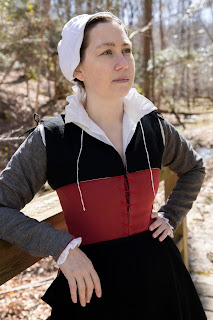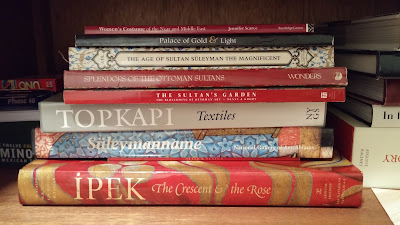Accessories For Styling an English Kirtle, 1500-1550
Now that we've covered the basics of the kirtle, I'm going to talk about the layers and accessories that complete the English look. This style is suitable for the middle classes during the first half of the 16th century.
Firstly is the garment worn against the skin- a shift. In the 16th century, linen was used to make undergarments. It wicks moisture away from the skin much better than cotton. Shifts can be made with different necklines. They can be square, rounded, gathered on a neckband, or high with a collar. The collar can also have a ruffle attached, which is what I chose to make. I already have shifts with low necklines, so I wanted to make a collared one. I suggest either the Tudor Tailor gridded book pattern, or purchasing that pattern from their Etsy. I also recommend Margo Anderson's Elizabethan undergarments pattern. My shift has two rectangular body pieces, two triangular hip gores, two square armpit gussets, and a collar and cuffs with a ruffle. The shift should reach at least to the knees; mine is calf length.
Simon Bening, Heures de Hennessy, early 16th century.This partlet is worn over the kirtle. Partlets could be white linen and look like the top of a shift, and this style can be worn under or over the kirtle. My partlet is made from black worsted wool and is designed to go over the kirtle, as seen in paintings from the time. It closes with a hook and eye at center front. It is lined in white linen. I used the partlet pattern from the Tudor Tailor book. Over partlets like this were frequently black- wool for the middling sort, silks (velvet, damask) for the nobility. Sometimes they were lined with fur.
Portrait of Jane, Lady Lister. Hans Holbein the Younger, 1532-1543. Royal Collection, Windsor Castle.
The sleeves are a separate item. They are made from matching pink wool and lined with grey linen. They are fully reversible. They have a handbound eyelet at the top for tying into the rings sewn on the shoulders of the kirtle. Sleeves were commonly separate from the kirtle and could be tied or pinned on.
The apron is made from black worsted wool. It is a rectangle of fabric sewn to a waistband tape. The last few inches of the top of the apron are left hanging off the waistband, sometimes referred to as a "dog eared apron". Linen and wool aprons were used in the 16th century.
Field of the Cloth of Gold (detail).
A cap (or coif) would have been worn by adult and married women of all classes. They were usually made from white linen and had various shapes. Generally it is a caul (usually circular) gathered to a band, then attached to a shaped piece that went around the head. Often another cap or hat was worn on top of the linen cap. Mine is modified from the Tudor Tailor book pattern to have a smaller shaped face piece.
Hans Holbein the Younger, An unidentified woman. Early 16th C.
Marcus Gheeraerts the Elder, Festival at Bermondsey, circa 1570.
Lastly are the shoes and stockings. My shoes are red leather in a square toe shape with slashing on the vamp. Stocking were usually made from wool cloth cut on the bias to allow for stretch, but knitted ones could be possible. I chose knitted wool stockings.
Websites I recommend:











Nice to read something valuable on this internet :)
ReplyDeleteFashion has an amazing history, it's worth knowing such interesting facts :)
ReplyDelete